The Binary Drivers Market is estimated to be valued at USD 607.2 million in 2025 and is projected to reach USD 1603.8 million by 2035, registering a compound annual growth rate (CAGR) of 10.2% over the forecast period.
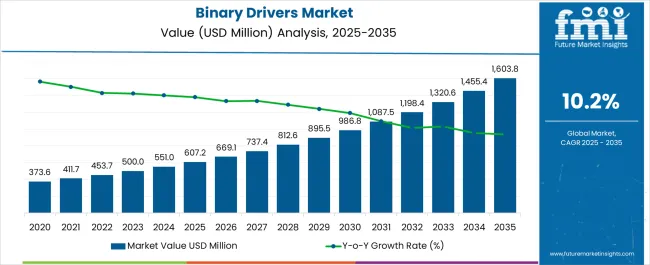
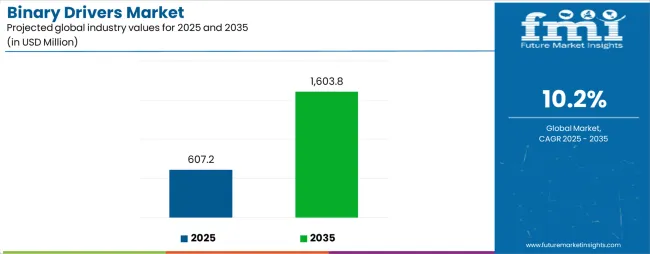
| Metric | Value |
|---|---|
| Binary Drivers Market Estimated Value in (2025 E) | USD 607.2 million |
| Binary Drivers Market Forecast Value in (2035 F) | USD 1603.8 million |
| Forecast CAGR (2025 to 2035) | 10.2% |
The Binary Drivers Market is gaining momentum as enterprises and developers increasingly rely on precompiled driver packages to enable seamless hardware and software integration. The current market landscape is characterized by rising adoption of binary-only drivers across industries where proprietary technologies dominate and intellectual property needs to be safeguarded.
Demand has been further influenced by the growing diversity of hardware devices and the necessity for drivers that ensure stable performance across multiple platforms without exposing source code. Future outlook for the market is shaped by increasing emphasis on data security, compliance, and performance optimization, as organizations require driver solutions that minimize compatibility risks.
Continuous innovation in chipsets, networking systems, and high-performance computing environments is also fostering the demand for reliable binary drivers With expanding digital ecosystems and faster product release cycles, software developers and OEMs are prioritizing drivers that can be deployed rapidly and updated efficiently, creating strong opportunities for sustained growth in this market.
The binary drivers market is segmented by type, device class, and geographic regions. By type, binary drivers market is divided into Media Binary Drivers, Database Binary Drivers, Executable Binary Drivers, Application Data Binary Drivers, Configuration Binary Drivers, Document Drivers, Library Drivers, and Encryption And Compression Binary Drivers. In terms of device class, binary drivers market is classified into Character Devices, Block Devices, and Network Interfaces. Regionally, the binary drivers industry is classified into North America, Latin America, Western Europe, Eastern Europe, Balkan & Baltic Countries, Russia & Belarus, Central Asia, East Asia, South Asia & Pacific, and the Middle East & Africa.
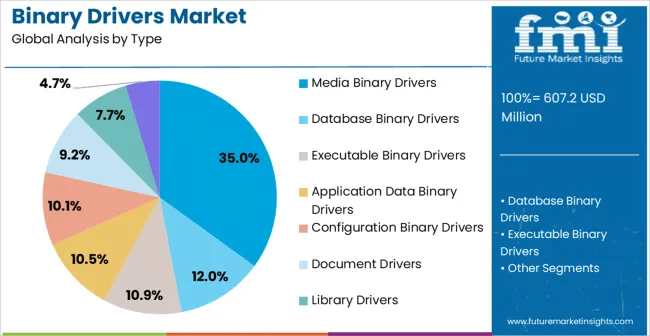
The Media Binary Drivers segment is expected to account for 35.0% of the Binary Drivers Market revenue share in 2025, establishing its position as a leading type. This prominence is being attributed to the extensive reliance on binary drivers to support multimedia hardware such as audio, video, and graphic processing units.
Media devices require consistent updates and reliable compatibility to handle the rapid evolution of content formats, streaming standards, and real-time rendering technologies. The preference for binary drivers in this segment has been influenced by the need to protect proprietary algorithms while delivering high-performance results across operating systems.
Growth has also been supported by the expansion of digital entertainment platforms, gaming applications, and immersive technologies, all of which demand advanced driver capabilities that can be maintained without exposing sensitive intellectual property With multimedia consumption continuing to expand across mobile, cloud, and enterprise ecosystems, the share of media binary drivers is expected to grow steadily, supported by ongoing demand for robust and easily deployable driver solutions.
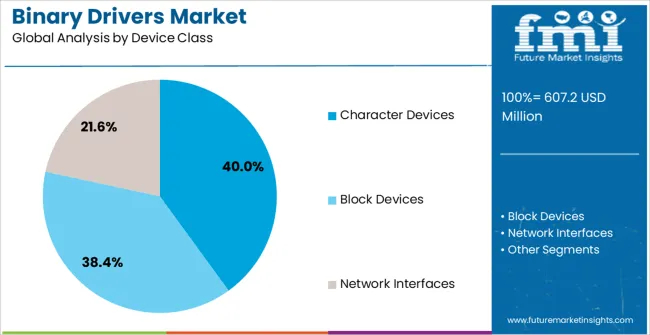
The Character Devices segment is projected to hold 40.0% of the Binary Drivers Market revenue share in 2025, making it the dominant device class. This strong position is being driven by the widespread use of binary drivers for devices that handle data in a sequential stream, such as keyboards, serial ports, and sensors, which require consistent and efficient communication with operating systems.
The growth of this segment has been reinforced by the need for reliable, low-latency drivers that can ensure accurate and uninterrupted performance in critical computing environments. Proprietary binary drivers are often favored in this domain because they provide secure and optimized interaction with specialized hardware components while maintaining intellectual property protection.
Increased demand from industries including industrial automation, IoT, and embedded systems has further accelerated adoption, as these sectors rely heavily on devices that function through character-oriented interfaces With connected devices proliferating rapidly and edge computing becoming more prevalent, the share of character devices is anticipated to remain substantial, reflecting their essential role in enabling seamless hardware integration and performance stability.
Integrating binary drivers into an Operating System (OS) enables operators to use the corresponding hardware devices. Binary drivers mediate the communication between a specific device and the corresponding operating system kernels.
These binary drivers are marketed either by the hardware supplier or the operating system developer. Typically, hardware manufacturers and suppliers offer binary drivers for the most popular operating systems in the market.
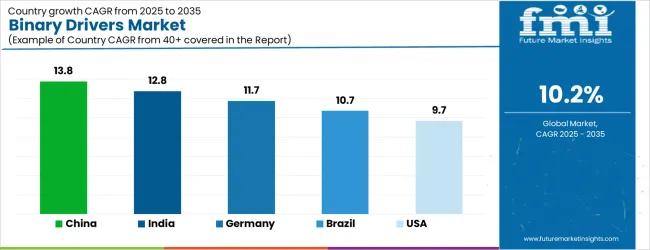
| Country | CAGR |
|---|---|
| China | 13.8% |
| India | 12.8% |
| Germany | 11.7% |
| Brazil | 10.7% |
| USA | 9.7% |
| UK | 8.7% |
| Japan | 7.7% |
The Binary Drivers Market is expected to register a CAGR of 10.2% during the forecast period, exhibiting varied country level momentum. China leads with the highest CAGR of 13.8%, followed by India at 12.8%. Developed markets such as Germany, France, and the UK continue to expand steadily, while the USA is likely to grow at consistent rates. Japan posts the lowest CAGR at 7.7%, yet still underscores a broadly positive trajectory for the global Binary Drivers Market.
In 2024, Germany held a dominant revenue in the Western Europe market and is expected to grow with a CAGR of 11.7%. The USA Binary Drivers Market is estimated to be valued at USD 224.9 million in 2025 and is anticipated to reach a valuation of USD 224.9 million by 2035. Sales are projected to rise at a CAGR of 0.0% over the forecast period between 2025 and 2035. While Japan and South Korea markets are estimated to be valued at USD 32.1 million and USD 17.5 million respectively in 2025.
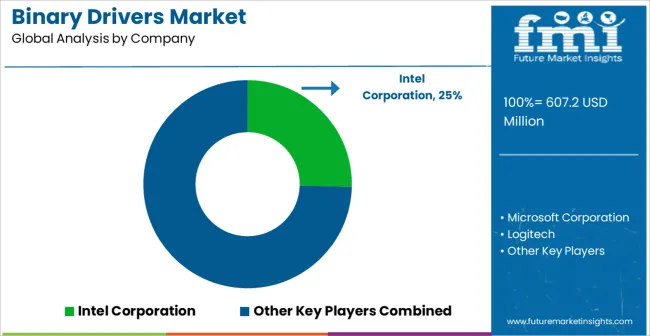
| Item | Value |
|---|---|
| Quantitative Units | USD 607.2 Million |
| Type | Media Binary Drivers, Database Binary Drivers, Executable Binary Drivers, Application Data Binary Drivers, Configuration Binary Drivers, Document Drivers, Library Drivers, and Encryption And Compression Binary Drivers |
| Device Class | Character Devices, Block Devices, and Network Interfaces |
| Regions Covered | North America, Europe, Asia-Pacific, Latin America, Middle East & Africa |
| Country Covered | United States, Canada, Germany, France, United Kingdom, China, Japan, India, Brazil, South Africa |
| Key Companies Profiled | Intel Corporation, Microsoft Corporation, Logitech, NVIDIA Corporation, Google, Maxim Integrated, and Broadcom Inc. |
The global binary drivers market is estimated to be valued at USD 607.2 million in 2025.
The market size for the binary drivers market is projected to reach USD 1,603.8 million by 2035.
The binary drivers market is expected to grow at a 10.2% CAGR between 2025 and 2035.
The key product types in binary drivers market are media binary drivers, database binary drivers, executable binary drivers, application data binary drivers, configuration binary drivers, document drivers, library drivers and encryption and compression binary drivers.
In terms of device class, character devices segment to command 40.0% share in the binary drivers market in 2025.






Our Research Products

The "Full Research Suite" delivers actionable market intel, deep dives on markets or technologies, so clients act faster, cut risk, and unlock growth.

The Leaderboard benchmarks and ranks top vendors, classifying them as Established Leaders, Leading Challengers, or Disruptors & Challengers.

Locates where complements amplify value and substitutes erode it, forecasting net impact by horizon

We deliver granular, decision-grade intel: market sizing, 5-year forecasts, pricing, adoption, usage, revenue, and operational KPIs—plus competitor tracking, regulation, and value chains—across 60 countries broadly.

Spot the shifts before they hit your P&L. We track inflection points, adoption curves, pricing moves, and ecosystem plays to show where demand is heading, why it is changing, and what to do next across high-growth markets and disruptive tech

Real-time reads of user behavior. We track shifting priorities, perceptions of today’s and next-gen services, and provider experience, then pace how fast tech moves from trial to adoption, blending buyer, consumer, and channel inputs with social signals (#WhySwitch, #UX).

Partner with our analyst team to build a custom report designed around your business priorities. From analysing market trends to assessing competitors or crafting bespoke datasets, we tailor insights to your needs.
Supplier Intelligence
Discovery & Profiling
Capacity & Footprint
Performance & Risk
Compliance & Governance
Commercial Readiness
Who Supplies Whom
Scorecards & Shortlists
Playbooks & Docs
Category Intelligence
Definition & Scope
Demand & Use Cases
Cost Drivers
Market Structure
Supply Chain Map
Trade & Policy
Operating Norms
Deliverables
Buyer Intelligence
Account Basics
Spend & Scope
Procurement Model
Vendor Requirements
Terms & Policies
Entry Strategy
Pain Points & Triggers
Outputs
Pricing Analysis
Benchmarks
Trends
Should-Cost
Indexation
Landed Cost
Commercial Terms
Deliverables
Brand Analysis
Positioning & Value Prop
Share & Presence
Customer Evidence
Go-to-Market
Digital & Reputation
Compliance & Trust
KPIs & Gaps
Outputs
Full Research Suite comprises of:
Market outlook & trends analysis
Interviews & case studies
Strategic recommendations
Vendor profiles & capabilities analysis
5-year forecasts
8 regions and 60+ country-level data splits
Market segment data splits
12 months of continuous data updates
DELIVERED AS:
PDF EXCEL ONLINE
Binary High Pressure Gradient Liquid Chromatography System Market Size and Share Forecast Outlook 2025 to 2035
Drill Drivers Market Size and Share Forecast Outlook 2025 to 2035
Display Drivers Market Growth – Size, Demand & Forecast 2025 to 2035
Non-isolated LED Drivers Market Size and Share Forecast Outlook 2025 to 2035

Thank you!
You will receive an email from our Business Development Manager. Please be sure to check your SPAM/JUNK folder too.
Chat With
MaRIA